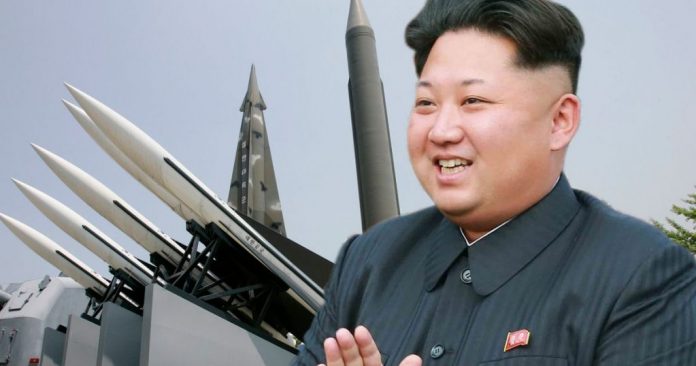
North Korea said Friday that its test of a “new type of tactical guided weapon,” overseen by leader Kim Jong Un, was a demonstration of its power and a “solemn warning to South Korean military warmongers” – a declaration that underlines how relations between the two Koreas are deteriorating as tensions rise.
The test of short-range ballistic missiles is a violation of United Nations Security Council resolutions, but President Donald Trump played down its significance.
“They really haven’t tested missiles other than, you know, smaller ones, which is something that lots test,” he told Sean Hannity on Fox News.
The Korean Central News Agency said the launch was a response to joint U.S.-South Korea military exercises, as well as South Korea’s introduction of “ultramodern offensive weapons.” It said Kim had vowed to continue to develop and test North Korea’s weapons systems in direct response.
Experts said the complaint about South Korean offensive weapons was almost certainly a reference to Seoul’s imports of F-35A stealth fighter jets from the United States, a move Pyongyang has already denounced as “extremely dangerous.”
South Korea described Thursday’s launch as a new type of short-range ballistic missile, saying one had flown about 260 miles and the other 430 miles.
That followed a similar test of short-range ballistic missiles in May, and experts said it was a threat to South Korea and U.S. forces there, experts said.
It was the first missile launch since President Trump met Kim at the demilitarized zone between the two Koreas at the end of June, casting fresh doubts on the effectiveness of that summit in moving the peace process forward.
The United States played down the significance of the test. Secretary of State Mike Pompeo said Kim had promised Trump in June not to test intermediate or long-range ballistic missiles, and said this test would not derail efforts to restart working-level talks between the two sides.
“I think this allows the negotiations to continue,” he told Fox News. “You know, lots of countries posture before they come to the table.”
The Combined Forces Command, representing the U.S. and South Korean militaries, also issued a statement Friday saying “the short range ballistic missiles were not a threat directed at [South Korea] or the U.S., and have no impact on our defense posture.”
But North Korea’s state news agency portrayed the test very differently.
Kim personally guided and supervised Thursday’s launch, KCNA said, “as part of the power demonstration to send a solemn warning to the South Korean military warmongers,” who it said are “running high fever” by importing new weapons and holding military exercises “in defiance of the repeated warnings” by North Korea.
Earlier this month, North Korea also warned that planned military exercises involving U.S. and South Korean forces would jeopardize proposed disarmament talks with Washington, and hinted that it might respond by resuming nuclear and missile tests. It accused Trump of reneging on a commitment to suspend the exercises.
Kim had mounted an observation post to guide the successful weapons tests, KCNA reported. “And it must have given uneasiness and agony to some targeted forces enough as it intended.”
Kim said the new tactical guided weapon, with a low altitude and “leaping flight,” would be hard to detect, calling it “of huge eventful significance in developing our armed forces and guaranteeing the security of the country by military force.”
Although Trump repeatedly sought to play down North Korea’s last short-range ballistic missile test in May, experts said the new missiles are a direct threat to Seoul, capable of carrying both nuclear and conventional warheads and designed to fly low enough to potentially avoid detection and interception by South Korea’s THAAD and Patriot missile defense systems.
“North Korea can increase survivability of its missiles by continuously moving them, hiding them in tunnels, warehouses and even highway underpasses,” said Duyeon Kim of the Center for a New American Security. “If these are an Iskander-style missile, then they could have jet vanes, which means it can be maneuvered during its ballistic trajectory, making it difficult to predict where the missile will land and intercept it before it does.”
South Korea’s Joint Chiefs of Staff said Thursday’s missiles were similar to the Iskander, a Russian mobile short-range ballistic-missile system that was a successor to the Soviet Scud missile.
South Korea had also underplayed May’s missile test, in an apparent attempt not to derail the delicate state of talks, but on Thursday it finally acknowledged that North Korea had tested ballistic missiles.
Kim said North Korea was determined to counter South Korea’s introduction of offensive weapons, which he called “suicidal” and a direct threat to the North, and said he was determined to steadily develop and test the North’s own weapons in response.
“The South Korean chief executive should not make a mistake of ignoring the warning from Pyongyang, however offending it may be,” KCNA said.
(c) 2019, The Washington Post · Simon Denyer
{Matzav.com}











